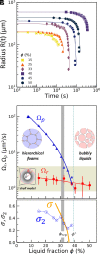Hierarchical bubble size distributions in coarsening wet liquid foams
- PMID: 37708201
- PMCID: PMC10515135
- DOI: 10.1073/pnas.2306551120
Hierarchical bubble size distributions in coarsening wet liquid foams
Abstract
Coarsening of two-phase systems is crucial for the stability of dense particle packings such as alloys, foams, emulsions, or supersaturated solutions. Mean field theories predict an asymptotic scaling state with a broad particle size distribution. Aqueous foams are good model systems for investigations of coarsening-induced structures, because the continuous liquid as well as the dispersed gas phases are uniform and isotropic. We present coarsening experiments on wet foams, with liquid fractions up to their unjamming point and beyond, that are performed under microgravity to avoid gravitational drainage. As time elapses, a self-similar regime is reached where the normalized bubble size distribution is invariant. Unexpectedly, the distribution features an excess of small roaming bubbles, mobile within the network of jammed larger bubbles. These roaming bubbles are reminiscent of rattlers in granular materials (grains not subjected to contact forces). We identify a critical liquid fraction [Formula: see text], above which the bubble assembly unjams and the two bubble populations merge into a single narrow distribution of bubbly liquids. Unexpectedly, [Formula: see text] is larger than the random close packing fraction of the foam [Formula: see text]. This is because, between [Formula: see text] and [Formula: see text], the large bubbles remain connected due to a weak adhesion between bubbles. We present models that identify the physical mechanisms explaining our observations. We propose a new comprehensive view of the coarsening phenomenon in wet foams. Our results should be applicable to other phase-separating systems and they may also help to control the elaboration of solid foams with hierarchical structures.
Keywords: Ostwald ripening; coarsening; foams.
Conflict of interest statement
The authors declare no competing interest.
Figures




References
-
- Wang K., Glicksman M., Phase coarsening in thin films. JOM 67, 1905–1912 (2015).
-
- Voorhees P. W., Ostwald ripening of two-phase mixtures. Annu. Rev. Mater. Sci. 22, 197–215 (1992).
-
- Nanev C. N., Recent experimental and theoretical studies on protein crystallization. Cryst. Res. Technol. 52, 1600210 (2017).
-
- Noorduin W. L., Vlieg E., Kellogg R. M., Kaptein B., From Ostwald ripening to single chirality. Angew. Chem. Int. Ed. 48, 9600–9606 (2009). - PubMed
-
- Asua J. M., Ostwald ripening of reactive costabilizers in miniemulsion polymerization. Euro. Polym. J. 106, 30–41 (2018).
Grants and funding
LinkOut - more resources
Full Text Sources
Research Materials

